The research of the Templar history in these parts is very difficult because of a lack of preserved documentation and monuments. The first extensive work dealing Templars is the work of Ivan Kukuljević Sakcinski entitled „The Vranski Priory with the Knights Templar and Hospitaller of St. John in Croatia“, published in 1886.
The First Encounter in our Parts
From the beginning of the Crusades, armies of crusaders crossed our lands. This is a preserved description of their passing through Slavonia1 on their way to the Holy Land by the canon Raymund des Agiles in 1096: „Of the evils French army suffered in Slavonia. Entering Slavonia, on their way they had many losses, mostly due to the harsh winter in those parts. For Slavonia is a land desolate, no roads, and mountainous, where we saw no animals nor birds for three weeks. The residents in those parts are so aggressive and primitive that they would not trade with us nor offer us guidance, yet, whilst fleeing their villages and fortified towns, brutally killed weak old and pauper sick people, who, due to their illness, followed our army from the distance, and by doing so, dealt us a great damage. And it was not easy to our armed soldiers chasing unarmed bandits who were familiar with the terrain, through broken hills and thick forrests; still they suppressed them steadily – not wanting to fight, they couldn’t stand without fighting […] Because of such state of things, the God wanted for His army to pass through Slavonia, so that the savages who knew no God, by perceiving the virtue and perseverance of the soldiers, be either discouraged of their savage ways or without pardon be taken before the ordeal.“2 After reading this western pilgrim’s view of these parts, it is obvious why the Templars started populating our parts soon after their establishment.
They came to these parts in period after the Second (1146-48) and before the Third Crusade (1187), thus between 1148 and 1187. Based on the preserved documents in several cases it is not possible to determine the exact year of the arrival of Templars to Croatia, that is, to their residences, respectively.
The purpose of their arrival was the protection of roads and travelers to the Holy Land. Western Europeans were not only lost in the southeastern parts of Europe, but also physically in danger by the local population to whom they distorted their peaceful living. The travelers needed strongholds, both Christian and defensive, and this could have been provided to them by warriors – monks, knights – Templars. All the leaders of that time were aware of this as well: the Roman pope, the Hungarian-Croatian kings, archbishops and bishops and other notables, thus the Templars were gladly appreciated.3 L. Dobronić states a few other possible reasons of their arrival: „Perhaps their expansion can be explained by the need to provide help and shelter to the crusaders who, already during the First Crusade, passed through our lands, and perhaps also by an effort to spread Christianity in probably mostly pagan lands at that time.“4
Various documents include names of Templars, especially of the Magister of Hungary and Croatia, along with preceptors and other brethren. The names suggest that most of the Templars in Croatia and Hungary originated from Romanic countries, especially regions of France. By entering the Order, they denounce all their titles, and they simply go by their first name with a prefix brother. Our own people in the Order of the Templars are rarely mentioned in the scripts. Nevertheless, there are a few Croatian, or Slavenic names which prove that also native young men have been admitted to this knights order.5
Organization in Croatia
The Order of the Templars was governed by the Great Magister, and the order was divided into provinces. Croatian lands were, along with Hungary, all in one province, which was governed by the magister per Ungariam et Sclavoniam. The templar magistri, chiefs for Hungary and Croatia, enjoyed a high position in contemporary society, and, for example, worked as counselors and witnesses in noblemen disputes.
Preceptories are organizational units governed by a preceptor or his second in command. In some cases, the preceptor was not a knight monk, but only a layman. There were several preceptories in Croatian area: Vrana, Gora, Glogovnica, Senj, Dubica, St. Martin (Božjakovina) and Našice.
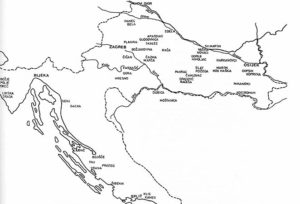 Judging by the artefacts preserved in Croatia, one cannot say how these residences looked like. Even in Western Europe, there are relatively little remains of templar buildings. However, there are certain characteristics of templar headquarters that are known. The headquarters of the preceptory were called mayur – which was a cluster of economic buildings on the safest and most profitable estate. Commonly, it was a foursquare yard with a chapel in the southern end, residential building in the northern end, and stables, which were especially important, because the Templars bred horses for their knights. Sometimes, in one corner of such complex there was a tower, but in most cases, these headquarters had more agricultural than defensive role. The fortified ones mostly derive from the times after the abolishment of the order, for example, in Vrana.6
Judging by the artefacts preserved in Croatia, one cannot say how these residences looked like. Even in Western Europe, there are relatively little remains of templar buildings. However, there are certain characteristics of templar headquarters that are known. The headquarters of the preceptory were called mayur – which was a cluster of economic buildings on the safest and most profitable estate. Commonly, it was a foursquare yard with a chapel in the southern end, residential building in the northern end, and stables, which were especially important, because the Templars bred horses for their knights. Sometimes, in one corner of such complex there was a tower, but in most cases, these headquarters had more agricultural than defensive role. The fortified ones mostly derive from the times after the abolishment of the order, for example, in Vrana.6
Judging by the architecture, in the countries of Western Europe, the Templars were mostly peaceful farmers. On the cotrary, In lands where they waged battles (in the Holy Land against Saracens, and on the Pyrenees against Moors), buildings (burgs) reveal their military significance. In Italy, defensive and agricultural characteristics mixed. The type of Croatian templar headquarters is still unknown.
In every templar headquarters, no matter of its significance, there was a chapel. Already in 1139 had the Pope Innocent II permitted Templars to build chapels for their own needs, in which the Service of God would be conducted by templar priests, and which would be outside of jurisdiction of local bishops. Layouts of templar chapels were mostly very simple: rectangle ending beyond the altar either by a flat wall or by a circular apse, and the buildings themselves were of small dimensions.
The Templars lived in very small groups, each one in its own „house“, which was the headquarters of the preceptory. Besides the knights and priests, there were also butlers and servants, especially for horse breeding. The Templars, much like other feudal lords, rented some of their estates to predials (along with certain obligations), and the land was cultivated by the local peasants.7
The Properties
The Templars gained their first properties in Croatia during the reign of king Stephen III (1162 – 1172). He confirmed their ownership of Zdela, which was a donation by a Bosnian count Borić, who was originally from Slavonia and owned land between the rivers Sava and Drava. He was a bosnian ban from 1154 to 1163, when he donated Zdela to the Templars, which is considered to be their first estate in our parts. The same king confirmed their ownership of the Haco estate which was donated to them by Gutimir, Prefect of Gora. These two were the first to donate land to the Templars in our parts, and probably due to spirit of knighthood they both nurtured.8
Vrana
The Vrana estate was donated to the Templars by the Pope, which was written in a letter in which pope Alexander III informs the Split archbishop Gerard of the donation, on February 18, 1169. The donation probably took place at some point between 1165 and 1169, and it was in their possession until the abolishment of the order. 9
The bishop of Nin donated them the church of St. Peter in Bojišće (in Ravni Kotari), and the Templars built a „hospital“ (a doss house), an object typical of their activity. Pope Urban III takes them under his protection in 1186, approving thereby all the eventual future donations, and in addition grants them permission to accept priests and laymen seeking shelter from the outside world. This „hospital“ was built by the Templars to welcome travelers, which was one of their main missions, so it is understandable that the pope supported such activity.
The advantage Vrana offered was nearness of the sea. Between Vrana and the sea lies Lake Vransko or Vransko blato (in literal translation „Mud of Vrana“), therefore the land between the lake and the sea iz called Zablaće („land behind the mud“). That was also the name of the harbor, which the templar ships carrying grains from Italy used as docking space. The harbour itself was probably located near today’s Pakoštane.
A document from 1284 contains the names of the Templars of Vrana. There were five brethren, which were most likely the only residents of Vrana (besides a couple of butlers and servants) at that time. The templar communities everywhere were sparse, and especially in these parts where there were not many Templars altogether. They had buildings in the area called Palača („Palace“), and that expression could mean that at that period Vrana was not a fortified town, and that the Templars there may have lived in the monastery („palace“) which was donated to them by the Pope in 1169, and which was previously donated to the Pope by king Zvonimir as a residence for Pope’s legates in Croatian kingdom.
Much like his predecessor, king Bela III (1172 – 1196) was also very favorable to the Templars, thus the Templars gained many estates during his reign.
Nova Ves, Zagreb
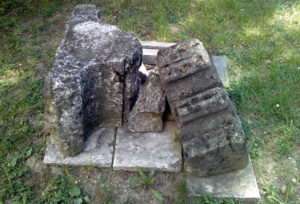 There are no immediate historical sources about the Templars in Zagreb, but we learn of them from much later writers. Daniel Farlati in the XVIII century writes about the Zagreb bishop Prodan: „Near Zagreb, in the area of today’s Nova Ves, he built a convent and a church for the templar brethren, as reported by Ivan, archdeacon of Gorica.“10 Prodan was a bishop in Zagreb in the period between 1172 and 1185, so the Templars came to Zagreb at that same period. They came here as early as the XII century, significantly before the founding of the Nova Ves colony (1344) and parish of St. John (1347).
There are no immediate historical sources about the Templars in Zagreb, but we learn of them from much later writers. Daniel Farlati in the XVIII century writes about the Zagreb bishop Prodan: „Near Zagreb, in the area of today’s Nova Ves, he built a convent and a church for the templar brethren, as reported by Ivan, archdeacon of Gorica.“10 Prodan was a bishop in Zagreb in the period between 1172 and 1185, so the Templars came to Zagreb at that same period. They came here as early as the XII century, significantly before the founding of the Nova Ves colony (1344) and parish of St. John (1347).
For a long time, it was difficult to guess the location of the templar headquarters with church. Recently, clues were discovered leading to some assumptions. During the renovation of the church of St. John in Nova Ves (1978) some stone fragments of quality gothic architectural plastics were discovered inside the wall. These fragments of a former gothic church were used as a construction material when pastor Sinković built today’s late-baroque church of St. John (1785 – 1790). A question emerged on the gothic church, which, judging by the size of the found fragments, must have been of monumental proportions, to which the fragments belonged. The old church was too small, which was the reason the pastor wanted to build a larger one. These fragments (capitals with indented gothic leaves and gothic fluted pilasters) couldn’t have been part of that small church. It is suspected that these fragments could be the last remnants of a former templar church. Lelja Dobronić finds a confirmation to this theory in a manuscript of Zagreb canon Antun Zdenčaj who, being a witness to the demolition of the old church in 1786, wrote that a church was torn down which was also Templars’ headquarters. This would mean that the old church of St. John had been raised in a place of Templars’ headquarters.11 He continues by stating that a chapel was then built for the Templars diagonally across the church of St. John (up north, along the Znikina Street). On that same spot had been built the chapel of St. Zachary some time before 1347. The chapel titular, who has never been mentioned as a church patron in Croatia, was a prophet who was killed in the Temple of Jerusalem, which also connects him to the Templars. It is also notable that the chapel was circular (conical) in shape, which was formerly considered typical for templar churches. Chapel of St. Zachary was torn down in 1781.12
This theory of templar headquarters in Nova Ves has a few problems. Namely, it doesn’t make much sense that someone would have a monumental gothic church torn down, in order to build a smaller church that would, eventually, be replaced by a bigger one. The dates also don’t match, because the fragments that were found are supposed to be dating from the XIV century.
Krčelić states that, following their abolishment, the Templars lived gathered in one place, in Nova Ves of Zagreb, under the authority of bishop Augustin Kažotić.
Glogovnica
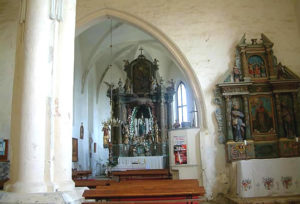 There is very little historical data on the Glogovnica preceptory. The most important information is that on March 12, 1240, a general council took place there, with Magister for the Kingdom of Hungary Rembald de Karump and other brethren.13 Glogovnica was a donation by the Zagreb bishop Prodan, probably in the period between 1172 and 1185.
There is very little historical data on the Glogovnica preceptory. The most important information is that on March 12, 1240, a general council took place there, with Magister for the Kingdom of Hungary Rembald de Karump and other brethren.13 Glogovnica was a donation by the Zagreb bishop Prodan, probably in the period between 1172 and 1185.
In today’s Glogovnica stands the parish church of St. Mary, which is interesting because of its double-naved architecture. The naves are divided by three columns, and are covered by a wooden ceiling. They are continued with an extended sanctuary supported by buttresses. It most likely ended with a semicircular apse, similar to many churches of the XIII century, which was later replaced by a gothic sanctuary. The facade was additionally extended with an octagonal belfry in the XIX century. Also, during the remodeling, two sculptures were embedded into the wall of the church, while the third one is held in the City Museum in Križevci. They have Romanesque characteristics, and definitely come from one of the churches in Glogovnica.
The earliest note on the church of St. Mary in Glogovnica dates from 1230, when pope Gregory IX sends a letter „to the Provost of the Blessed Virgin Mary in Glogovnica“.14 Then in XIV century there is some more information, regarding the Head of the Order of the Holy Sepulchre being named „the Provost of the church of the Blessed Virgin Mary in Glogovnica“. Therefore, it is certain that the Sepulchrals had a church dedicated to St. Mary in Glogovnica. This refutes the often quoted claim that today’s Church of Blessed Virgin Mary used to belong to the Templars, and then to Hospitallers afterwards.
But, this raises a question on the whereabouts of templar headquarters with church. There is no information about a templar church in any written document. The research is even more difficult knowing the fact that the templar church’s whereabouts were unknown already in the XVIII century. The literature, however, offers a few theories to a possible solution to this problem.
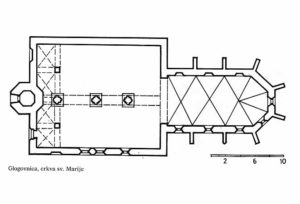 The first theory is one of Lelja Dobronić, who, considering the previously stated facts, concludes that today’s parish church was definitely owned by the knights of the Holy Sepulchre. She continues stating that there is a „parish church of St. George in Glogovnica“ enlisted in the parish census of 1334. She explains that the church of St. George was likely a property of the Templars, and that it may have been turned to parish church during the Hospitaller period (after 1314). By the disappearance of Hospitallers and during the Turkish assaults, the church of St. George may have easily been abandoned, and the church of St. Mary, which belonged to the Order of the Holy Sepulchre, who also disappeared from this place, may have consequently become the new parish church. It was too difficult to maintain both churches in a place abandoned by all monks and most of population. The author corroborates her assumptions with the parish censuses of 1334 and 1501. She puts the church of St. George on the top of Crkvenjak (eng. Sacristan) hill, located southwest of today’s church. She explains such a location with a known fact that there was formerly a church on this hill top, and that the hill got its name after it. Besides that, a large amount of processed and split stones confirms a theory that there was a stone building on this spot.15
The first theory is one of Lelja Dobronić, who, considering the previously stated facts, concludes that today’s parish church was definitely owned by the knights of the Holy Sepulchre. She continues stating that there is a „parish church of St. George in Glogovnica“ enlisted in the parish census of 1334. She explains that the church of St. George was likely a property of the Templars, and that it may have been turned to parish church during the Hospitaller period (after 1314). By the disappearance of Hospitallers and during the Turkish assaults, the church of St. George may have easily been abandoned, and the church of St. Mary, which belonged to the Order of the Holy Sepulchre, who also disappeared from this place, may have consequently become the new parish church. It was too difficult to maintain both churches in a place abandoned by all monks and most of population. The author corroborates her assumptions with the parish censuses of 1334 and 1501. She puts the church of St. George on the top of Crkvenjak (eng. Sacristan) hill, located southwest of today’s church. She explains such a location with a known fact that there was formerly a church on this hill top, and that the hill got its name after it. Besides that, a large amount of processed and split stones confirms a theory that there was a stone building on this spot.15
Historical topographer Ranko Pavleš in his work entitled „The topography of two crusader estates in the valley of Glogovnica“ points to a different solution. He claims that the sepulchral estate was located in the area of today’s villages of Donja Glogovnica and Gornja Glogovnica, and Marinovci and east of them all the way to upper streams of Rasinja and Koprivnica creeks. Today’s parish church of Blessed Virgin Mary was also a part of it. The estate was in Sepulchrals’ possession from the end of XII century, and was lost in XV century to provosts of Zagreb, to be finally acquired by the Zagreb Jesuits. He claims that the Templars owned the church of St. John in today’s village of Ivanec. Their estate spread around the villages Ivanec, Vojakovac and Čabraj, and all the way to the Oslovica creek in the south. The Templars held it from 1175, and around the beginning of the XIV century it is taken over by the Hospitallers. He explains the lack of information on locations owned by these orders with the fact that,due to the Ottoman rampages in the XVI century, very little of aboriginal population stayedon both estates, thereby resulting in disappearance of most of the medieval toponyms.16
Vladimir Palošika develops a theorysimilar to the one of L. Dobronić in his book „Glogovnica: Parish church of Assumption of Mary“. He claims that the parish church of St. Mary took over patrocinium of the missing sepulchral church of unknown whereabouts. But, he also states that the recent archeological discoverings point out that the new church was built over the old one. He agrees that the church of St. George was templar, but he also claims that it didn’t necessarily have to be located in Glogovnica. He finally concludes: „After all the presented facts, I conclude that a small, but certain step has been made towards clarification of historical unknowns of Glogovnica by determining of Romanesque architectural plastics. Since these were accidental findings, Glogovnica remains a mistery. There will be no larger steps in clarification of vastness historical reality of Glogovnica until thorough preliminaries have been done, including style analysis, revision of historical sources, gathering and examining of all the literature on Glogovnica, examination of the church’s walls, floors, close and distant environment, and until the conclusion of comprehensive archeological research. Thereunto, full attention is to be given to a systematic research of toponyms and haghionyms, not only through literature, but also in field research, by talking to the local population of Glogovnica and surrounding villages“.17
Anđelko Badurina’s hypothesis is that the parish church of St. George, which was located in the Gornja Glogovnica or Donja Glogovnica, burnt down and was never restored afterwards. According to him, the sepulchral church of St. Mary and house of the Order were located at the place of today’s parish church of the Assumption of Mary in Glogovnica, which became the parish church only after their departure. He states that the possible builder of today’s church was Zagreb bishop Osvald Tuz. He places the templar house, with church, to a place called Garište, just over Čabraj. He also concludes that, in order to clarify the mistery of Glogovnica, systematical archeological research must take place „[…] on the entire area of the fort (castrum), where stands today’s parish church.“18
Gora
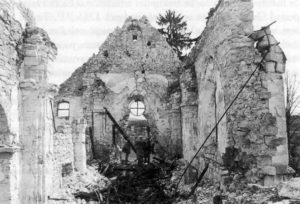 Gora19 was a donation to the Templars by Vukiš, which was approved by king Bela III. During his reign, the church of St. Mary in Gora already existed, and was, according to the sources, located inside the templar court, which makes it the oldest templar headquarters in Croatia, having been built before 1196.20
Gora19 was a donation to the Templars by Vukiš, which was approved by king Bela III. During his reign, the church of St. Mary in Gora already existed, and was, according to the sources, located inside the templar court, which makes it the oldest templar headquarters in Croatia, having been built before 1196.20
This originally templar church had been partially torn down, then repaired and rebuilt more than once, until its radical Baroque makeover in 1736.21 Single-naved medieval church had two aisles22, and it ended with an equally wide rectangular sanctuary. The entire medieval part was supported by buttresses. Within the inner side of the back wall of the sanctuary, behind the altar, there was a sacrarium.23 It had a wide round stone edge trefoil finnishing. Although a trefoil sacrarium is usually typical forGothic style, this particular one in Gora has a very round edge and belongs to Romannesque.
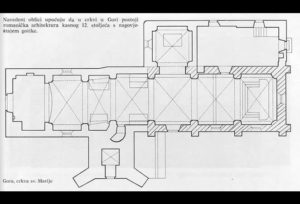 The contours of this church are an exact match to the ones on templar churches in France, which can be explained by the fact that most of our templar chiefs were French. As a confirmation, there is a very similar church in Špitalič, Slovenia. It is also single-naved, double-aisled church with a sanctuary ending by a flat wall. From the outside, it is also supported by buttresses, and it was built in 1190, approximately at the same time as the church in Gora. The church in Špitalič belonged to the order of French Carthusians, therefore its builders were also French. It is also a proven fact that the French builders operated in our parts in the XII century as well, so they could have easily built the templar church in Gora.24
The contours of this church are an exact match to the ones on templar churches in France, which can be explained by the fact that most of our templar chiefs were French. As a confirmation, there is a very similar church in Špitalič, Slovenia. It is also single-naved, double-aisled church with a sanctuary ending by a flat wall. From the outside, it is also supported by buttresses, and it was built in 1190, approximately at the same time as the church in Gora. The church in Špitalič belonged to the order of French Carthusians, therefore its builders were also French. It is also a proven fact that the French builders operated in our parts in the XII century as well, so they could have easily built the templar church in Gora.24
The forementioned contours on the church in Gora indicate a Rommanesque architecture of the late XII century, with an insinuation of Gothic. New researches conducted by Drago Miletić pose a slightly different thesis: „Due to a discovery of spolia, particularly the one with Rommanesque palmette, as well as traces of semicircular apse, he concludes, and assumes, that the Templars got a Rommanesque church along with the estate as a part of a donation by Bela III in 1196. This church was, for unknown reasons, disintegrated, and an early Gothic church, extended by a Baroque upgrade, was built in its place. Anyhow, this discovery of, upon recently unseen, interior of templar church in Gora, built most probably at the beginning of the XIII century, brings a new light in the understanding of Gothic, moreover early Gothic architecture in Croatia. The templar chiefs (Magisters and Preceptors) were almost exclusively French […]. Gothic in the XIII century in France was already highly developed. To Templars, with their French building experience and the means, it wasn’t hard to build a small church in Gora, one of their first headquarters in this part of Europe, and an important traveling path […]. In the nearby Slovenia Carthusian French had their French builders. So could the French Templars have their own builders.“25 Among the discovered fragments of decorative plastic in the church in Gora, there is a frieze with heart-shaped palmettes which links it to the same motif from the Benedictine church of St. Mary in Zadar.26 Aside from the few examples in Dalmatia, this motif is also present in a basilica in Székesfehérvár in Hungary. All this tells us that the church in Gora was one of the stages of the spreading of contours from Venice to Hungary, related to the regency of the Arpad dynasty, which also testifies of its importance in the Middle Ages.27
The church in Gora is still being restored after being devastated in the war. It was decided, though, that it will not be restored in Baroque style, like it had been before it was ruined, but it will rather be renovated to its prior early Gothic templar phase.28
Senj
Senj was donated to the Templars by king Bela III himself, along with the church of St. George. This is documented in the papal grant certificate from 1183 or 1184. Senj was especially important as a harbour, because it provided an important income.29 The city was lost in 1269, when, in exchange, they got the district of Dubica.
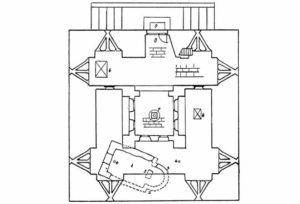 Already in XII century, they were also granted the small church of St. George, which doesn’t exist today, bringing up a question of the church’s location. It was usually assumed it was located in the village Jurjevo not far from Senj. Josip Frančišković did a research on this, and as a result he came to a conclusion that the templar headquarters with the church of St. George weren’t here, but in Abatovo bay, under Nehaj and Trbušnjak hill. His opinion is that the Templars here were succeeded by the Benedictines, which was acknowledged by Ivan Ostojić as well. From the material left from these medieval objects, in 1558 was built the city Nehaj. Ante Glavičić (long-time headmaster of the City Museum in Senj) declared that during the restoration of Nehaj-city in 1964 remnants were discovered of a pre-Rommanesque church. Glavičić is certain that these remnants are in fact the foundations of the church of St. George, which was given to the Templars along with Senj, from before 1183. Abatovo bay may have served as a harbourto the Templars, and later to the Benedictines, after whom it got its name (abas=abbot).30
Already in XII century, they were also granted the small church of St. George, which doesn’t exist today, bringing up a question of the church’s location. It was usually assumed it was located in the village Jurjevo not far from Senj. Josip Frančišković did a research on this, and as a result he came to a conclusion that the templar headquarters with the church of St. George weren’t here, but in Abatovo bay, under Nehaj and Trbušnjak hill. His opinion is that the Templars here were succeeded by the Benedictines, which was acknowledged by Ivan Ostojić as well. From the material left from these medieval objects, in 1558 was built the city Nehaj. Ante Glavičić (long-time headmaster of the City Museum in Senj) declared that during the restoration of Nehaj-city in 1964 remnants were discovered of a pre-Rommanesque church. Glavičić is certain that these remnants are in fact the foundations of the church of St. George, which was given to the Templars along with Senj, from before 1183. Abatovo bay may have served as a harbourto the Templars, and later to the Benedictines, after whom it got its name (abas=abbot).30
Bela III resolved the Templars of „zalazina“(„the entering obligation“), which was a feudal duty of welcoming members of the royal family, Croatian bans, and other dignitaries on their travels. They were free to decide whether to accept a guest or not, which was a great privilege in contemporary society.31
During his lifetime, the king pledged an oath to participate in the Third Crusade (1189 – 1192), but never fulfilled it. So, at his death bed, he transferred his oath to his son Andrew, obliging him to go to the Holy Land.32
He was succeeded by his son Emeric (1196 – 1204). Emeric kept good relations with the Knights Templar, showing his favor abundantly. He explained to them their rights in his land to the details, by these words: „All the estates and all goods, mobile and stationary, which in all of our kingdom they possess now or will, by the grace of God, acquire, together with the people and subordinates residing in our kingdom and practicing the chores of the Order of the Temple, we take under our royal defense, to joy under our Majesty’s protection and to be happy. We resolve them of paying levies, taxes, or any enforcement or anything to any man of public service. We grant, also, to the forementioned Holy Temple the freedom of water, pasture and dry wood, as well as market levies to all the houses of the Army of the Temple and to their people, along with a commandment that no one should even consider seeking of the brethren of the Holy Army of the Temple of Solomon and their people anything on behalf of pasture, fishing, collecting of dry wood, market levies or anything ordinary in land or sea, and that no one from them or the house of the Order of the Temple even have an intention to deprive – without court and justice – of possession or property, that they have in all our kingdom, and do not tantalize by unjust molestation their people, possessions and properties.“33
He was replaced on the throne by his younger brother Andrew II (1205 – 1235), who was extremely favorable to the Templars. In a document from 1209 he approved all donations to them from his predecessors.
The Land Of St. Martin – Božjakovina
The first use of the term „land of St. Martin“ can be found in the forementioned charter of king Andrew II, from 1209, by which the king donates this land to the Templars, so „to save his soul“. By their abolishment, similar to other cases, the land is taken over by the Hospitallers, and afterwards it is governed by the noble families Tahy, Drašković and Zrinski. Later, the more common term for this land will be Božjakovina, after the popular name for the Templars („Božjaci“).34
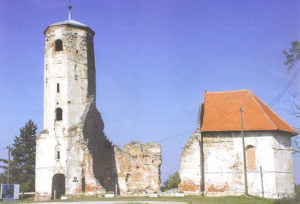 The exact location of the templar administrative center in the „land of St. Martin“ is still uncertain, but there is a common belief that the church of St. Martin in Prozorje was the most notable locality in this region. The name of this estate itself (terra saneti Martini) testifies there was a church of St. Martin, long before the Templars arrived, after which the estate got its name. That church was probably built in the IX century. Templars had a house (domus) here, that was also the headquarters of the St. Martin preceptory, but its location is a mistery as well. There were numerous assumptions to its whereabouts, the most logic being the one that it was located next to the church of St. Martin in Prozorje (Martin Breg), north of Dugo Selo.35
The exact location of the templar administrative center in the „land of St. Martin“ is still uncertain, but there is a common belief that the church of St. Martin in Prozorje was the most notable locality in this region. The name of this estate itself (terra saneti Martini) testifies there was a church of St. Martin, long before the Templars arrived, after which the estate got its name. That church was probably built in the IX century. Templars had a house (domus) here, that was also the headquarters of the St. Martin preceptory, but its location is a mistery as well. There were numerous assumptions to its whereabouts, the most logic being the one that it was located next to the church of St. Martin in Prozorje (Martin Breg), north of Dugo Selo.35
St. Martin on Martin Breg is a single-naved church with a trilateral end sanctuary. A belfry was added to the western facade at the end of the XVII century. Researches so far have discovered traces of several phases of construction and upgrade of the church. Remnants of two sacristies (earlier southern and later northern), along with two sideways chapels, that were mentioned in the documents – St. Three Kings (southern) and St. Barbara (norhern) – were discovered. Within the northern upgrades (the sacristy and the chapel) there are also visible individual older, spatially smaller structures. „Today’s church, whose core originated during the second half of the 15th century in late-Gothic style, lies on older, also Gothic foundations of a church with props around a polygonal sanctuary (probably built by the Hospitallers), although, those foundations, at least partially (specifically the foundations of the polygonal sanctuary with props) lie on even older foundations of what is most probably a Rommanesque apse (thickness of the discovered foundations – someplace over 2 meters – suggests that this was some sort of a church – fortress).“36
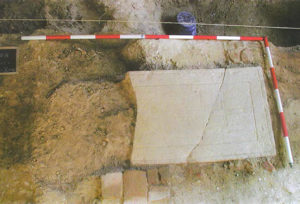 Best evidence of a templar presence is visible from a tombstone found inside the church. It was broken to half, and the upper part was preserved. The dimensions of the preserved part are 107 cm x 72 cm x 10-13 cm. The board displays a shallow etched shield, and a medieval sword over it. The entire borderline of thestone is covered in engravings. Since the stone was secondarily placed on a newer grave, we don’t know who it originally belonged to. Shape of the sword, conception of the shield and the style of the stone gravure all suggest that this tombstone originated at the transition between the XIII and XIV century. The sword is overstylized, with too few details and not legible enough to determine its type more precisely. The sword’s shaperessembles a cross, but also associates with knights orders. „Sword and shield motifs are a common detail on tombstones of medieval nobility, as on many tombs as well. However, the most similar to this one, by motif and by gravure style, is found on a templar tombstone found in their Portuguese center in Tomar, which strengthens the assumption that Martin-Breg is also Templars’ legacy.“37
Best evidence of a templar presence is visible from a tombstone found inside the church. It was broken to half, and the upper part was preserved. The dimensions of the preserved part are 107 cm x 72 cm x 10-13 cm. The board displays a shallow etched shield, and a medieval sword over it. The entire borderline of thestone is covered in engravings. Since the stone was secondarily placed on a newer grave, we don’t know who it originally belonged to. Shape of the sword, conception of the shield and the style of the stone gravure all suggest that this tombstone originated at the transition between the XIII and XIV century. The sword is overstylized, with too few details and not legible enough to determine its type more precisely. The sword’s shaperessembles a cross, but also associates with knights orders. „Sword and shield motifs are a common detail on tombstones of medieval nobility, as on many tombs as well. However, the most similar to this one, by motif and by gravure style, is found on a templar tombstone found in their Portuguese center in Tomar, which strengthens the assumption that Martin-Breg is also Templars’ legacy.“37
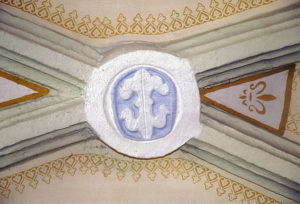 When we speak of templar presence in this land, one must mention the church of St. Brcko in nearby Brckovljani. The connection between these two churches is apparent by the fact that St. Bricius (Brcko),who was the immediate successor of Martin as bishop of Tours, is the church’s titular. It is located in similar way as the church of St. Martin on the hill dominating the surroundings. Rommanesque windows preserved in the sanctuary, capital of geommetric motifs, and especially two round head stones are considered as proof of a possibility that this could have been a church of an order of knights. The particular two head stones have low reliefs of two liliesin a mirror position. Some authors believe that this is a heraldically conceived motif ressembling the Hospitaller crest. This puts the ceiling of the church somewhere between the middle of XIV and end of XV century.38
When we speak of templar presence in this land, one must mention the church of St. Brcko in nearby Brckovljani. The connection between these two churches is apparent by the fact that St. Bricius (Brcko),who was the immediate successor of Martin as bishop of Tours, is the church’s titular. It is located in similar way as the church of St. Martin on the hill dominating the surroundings. Rommanesque windows preserved in the sanctuary, capital of geommetric motifs, and especially two round head stones are considered as proof of a possibility that this could have been a church of an order of knights. The particular two head stones have low reliefs of two liliesin a mirror position. Some authors believe that this is a heraldically conceived motif ressembling the Hospitaller crest. This puts the ceiling of the church somewhere between the middle of XIV and end of XV century.38
Vladimir Goss places the decorative stones from the church of St. Brcko in a wider perspective of templar art in Europe, especially France. According to his theory, rosettes are also, and especially lilies as a symbol of Mary’s virginity, undoubtedly related to knights orders, especially the Knigths Templar, from whom these same motifs could have been adopted by Hospitallers. He deems that the sanctuary of this church is the most completely preserved interior of a knights church in continental Croatia, although he agrees that it must have gone through many renovations. He assumes that the church was initially built or renovated by the Templars. Early theories even considered the posibility that this was the original church of St. Martin.39
Klis and Gacka
In order to fulfill his father’s oath, king Andrew goes to the Crusades in 1217. Whilst on journey, he donated two estates to the Templars. On his way to the Holy Land,he stopped at Split, and according to Toma the Archdeacon he intended to donate the Klis fortress to the Split people, so that he could defend the city from the rear. But, Toma states that the Split people didn’t care for the common good, so the king „summoned Pontius, who was the Magister of the army of Templars by the Kingdom of Hungary, and trusted him keep and protection of the citadel, givinghim an order to see that his brethren reside there in turns.“ Thereby, the Templars were donated the Klisfortressfrom king Andrew in 1217.40
Upon returning from the Holy war, as a token of gratitude to the Templars and their Magister Pontius of the Cross, who was also the king’s regent during the time of his absence, he grants them the land of Gacka. The king was grateful to them because they organized his journey to the Holy Land, enabled him a safe departure and return, bore all the expenses, and looked after the queen, who stayed behind.41
Našice
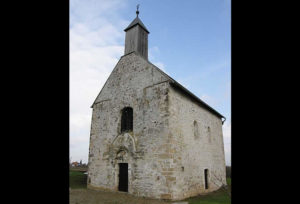 Našice were a donation by ban Jula, some time before 1230. The Templars probably built the church of St. Martin on that estate themselves. This is the only entirely preserved templar church in Croatia. The church is single-naved, with a semi-circular apse. The walls were built both of dressed and irregular stones, and on the outer walls there are dressed cuboids. The church’s nave is covered with a wooden ceiling, and the semicircular apse is barrel vaulted, opening by a wide round triumphal arc towards the nave. In the sanctuary there are two narrow windows with semi-circular endings, one in the central axis of the church, and the other in the southern wall. In the southern wall there are also two niches, both ending in a shape of round trefoil. One is a sacrarium, which is obvius by the dent in the bottom of the niche, and the other is a custody. On the southern wall of the nave there are two larger windows, similar to those in the sanctuary. On the facade there is a large Rommanesque, roundly topped window. During its renovation, discovered in the wall was a stone crest with a large and a small cross (small inside the large one) embossed in it, which is the symbol of the Knights of the Cross. Since the church wasn’t altered42 much in the renovations, it was preserved in almost original appearance.
Našice were a donation by ban Jula, some time before 1230. The Templars probably built the church of St. Martin on that estate themselves. This is the only entirely preserved templar church in Croatia. The church is single-naved, with a semi-circular apse. The walls were built both of dressed and irregular stones, and on the outer walls there are dressed cuboids. The church’s nave is covered with a wooden ceiling, and the semicircular apse is barrel vaulted, opening by a wide round triumphal arc towards the nave. In the sanctuary there are two narrow windows with semi-circular endings, one in the central axis of the church, and the other in the southern wall. In the southern wall there are also two niches, both ending in a shape of round trefoil. One is a sacrarium, which is obvius by the dent in the bottom of the niche, and the other is a custody. On the southern wall of the nave there are two larger windows, similar to those in the sanctuary. On the facade there is a large Rommanesque, roundly topped window. During its renovation, discovered in the wall was a stone crest with a large and a small cross (small inside the large one) embossed in it, which is the symbol of the Knights of the Cross. Since the church wasn’t altered42 much in the renovations, it was preserved in almost original appearance.
Near the church, there must have been a templar house somewhere, with economic buildings, probably even on the same hill as the church of St. Martin. Nevertheless, there were no traces found whatsoever, except some unevenness in the ground. The hill on which the church is located is surrounded by a wide trench, so the fortification was probably within that moat as well.43
Rassecha – Nova Rača
The sources mentioned a templar estate called Rassecha, but its whereabouts were unknown. After certain speculations, it was finally established that it was most probably located in the village of Nova Rača.44
Church of St. Mary in Nova Rača is a longitudinal single-naved Gothic room ending with a trilateral apse. The church was supported by buttresses from the outside. The interior was renovated in 1782, in Baroque style. A belfry supported by graded buttresses rises sideways of the church’s nave. The ground floor of the belfry is connected to the church, and star-vaulted. The entrance to the belfry goes through a cylindrical tower leaning onto it, and protectiong it up to a height just above the first floor.
Discovered on the southern wall of the church of St. Mary in Nova Rača was a memorial in latin. It states that the church was built by „the red brethren“45, and just before their abolishment. There is another interesting monument inside the church. In the belfry, on the first floor, on a stone jamb there is an engraved crest with prominent letters F R, a cross between them, and a half-moon and a six-pointed star above them. The letters were interpreted as fratres rubri (the red brethren), and the star and half-moon clearly resemble Christian-Muslim conflict.46
Lelja Dobronić explains the possible confusions regarding the datation of this church: „Some of the forementioned shapes might question the time of origin, so that it may well be assumed that the Hospitallers continued the construction started by the Templars. Some authors even deem that it was built at the end of XV or the beginning of XVI century. However, from 1975 – 1992 some archeological research took place with the intention to determine the existence of fortification and residence of the Knights Templar and Hospitaller in the Middle Ages. The excavations in the close proximity of the church were conducted by prof. G. Jakovljević from the Bjelovar Museum. The characteristics of the found numerous walls on the northern side of the church confirm the long continuity of life and construction, as is the case with today’s church, whose construction lasted for centuries.“47
Dubica
Templars were granted Dubica in 1269 during reign of Bela IV (1235 – 1270), as a compensation for Senj, which they had lost. The exact time of Templars’ arrival to Dubica is unknown, but it is certain that in 1240 they had a house and preceptory headquarters here, because at that period this was residence to Magister of Croatia and Hungary brother Jacob de Monte Regali.48 After the abolishment of the order, same as many other of their estates, Dubica is taken over by Hospitallers.
The Knights Templar came to our lands between the First and Second Crusade. The purpose of their arrival is in accordance with their mission, which is protection of travelers on their way to the Holy Land. However, by their arrival, they leave a significant influence in life and culture of local population. There is very little documentation preserved of their time spent here, and the preserved monuments are rather scarse as well. Of templar architecture, there is only one church that remained in tact (St. Martin at Našice), whilst others were later built over, completely run down or their location is unknown. Judging by the preserved elements, we can assume they built small, simple churches, single-naved and with a simple sanctuary. A few pieces of stone plastic were preserved as well. None of the templar houses (domus) were preserved.
After the abolishment of the Order of the Templars in the beginning of XIV century, their properties along with the buildings were, as in other countries, taken over by the Hospitallers.
- The purpose of their arrival was the protection of roads and travelers to the Holy Land. Western Europeans were not only lost in the southeastern parts of Europe, but also phisically in danger by the local population to which they distorted their peaceful living.
- The Order of the Templars was governed by the Great Magister, and the order was divided into provinces. Croatian lands were, along with Hungary, all in one province, which was governed by the magister per Ungariam et Sclavoniam.
- The Templars lived in very small groups, each one in its own „dwelling“, the headquarters of the preceptory.
- Templars’ estates were mostly donations from kings and lords.
- Lojzo BUTURAC: Templarska crkva u Gorama kod Petrinje, Godišnjak Gradskog muzeja Sisak, Sisak, 2011. (u tisku)
- Lelja DOBRONIĆ: Posjedi i sjedišta templara, ivanovaca i sepulkralaca u Hrvatskoj, Rad Jugoslavenske akademije znanosti i umjetnosti, Zagreb, 1984.
- Lelja DOBRONIĆ: Viteški redovi, templari i ivanovci u Hrvatskoj, Kršćanska sadašnjost, Zagreb, 1984.
- Lelja DOBRONIĆ: Templari i ivanovci u Hrvatskoj, Dom i svijet, Zagreb, 2002.
- Žarko DOMLJAN (gl. ur.): Križevci grad i okolica, Institut za povijest umjetnosti Sveučilišta u Zagrebu, Zagreb, 1993.
- Mladen HOUŠKA (ur.): Templari i njihovo nasljeđe, 800 godina od dolaska templara na Zemlju sv. Martina (katalog izložbe), Muzej sv. Ivan Zelina, Sv. Ivan Zelina, 2009.
- Juraj BELAJ, Templari i ivanovci na Zemlji Svetog Martina, u:Templari i njihovo nasljeđe, 800 godina od dolaska templara na Zemlju sv. Martina, [ur.) Mladen HOUŠKA], 14-27, Muzej Sv. Ivan Zelina, Sveti Ivan Zelina, 2009.
- Vlado KRUHAK, “Zemlji Svetog Martina” 1209.-2009., u:Templari i njihovo nasljeđe, 800 godina od dolaska templara na Zemlju sv. Martina, [ur.) Mladen HOUŠKA], 5, Muzej Sv. Ivan Zelina, Sveti Ivan Zelina, 2009.
- Drago MILETIĆ: Župna crkva Uznesenja Blažene Djevice Marije u Gori, u: Godišnjak zaštite spomenika kulture Hrvatske 22/23, 1996-1997, 127.-150.
- Vladimir PALOŠIKA: Glogovnica: Župna crkva Uznesenja Marijina, Meridijani, Samobor, 2010.
- Ranko PAVLEŠ: Topografija dvaju posjeda križničkih redova u dolini Glogovnice, u: Cris, god. VII., br. 1/2005., 14-23.
- 1 Slavonia is a name after which the Western writers denoted the lands of Slavenic tribes.
- 2 Lelja DOBRONIĆ: Viteški redovi, templari i ivanovci u Hrvatskoj, Kršćanska sadašnjost, Zagreb, 1984, 21-22.
- 3 Lelja DOBRONIĆ: Templari i ivanovci u Hrvatskoj, Dom i svijet, Zagreb, 2002., 27.
- 4 Lelja DOBRONIĆ: Posjedi i sjedišta templara, ivanovaca i sepulkralaca u Hrvatskoj, Rad Jugoslavenske akademije znanosti i umjetnosti, Zagreb, 1984.,9.
- 5 Lelja DOBRONIĆ (note 2), 27-28.
- 6 Lelja DOBRONIĆ (note 2), 81.
- 7 Lelja DOBRONIĆ (note 2), 28.
- 8 Lelja DOBRONIĆ (note 2), 28-29.
- 9 Lelja DOBRONIĆ (note 2), 82-83.
- 10 Lelja DOBRONIĆ (note 2), 111.
- 11 Lelja DOBRONIĆ (note 2), 111-112.
- 12 Lelja DOBRONIĆ (note 2), 112.
- 13 On this council it was decided that the Senj Templars would be transferred to Dubica.
- 14 Lelja DOBRONIĆ (note 4), 132.
- 15 Lelja DOBRONIĆ (note 4), 133.
- 16 Ranko PAVLEŠ: Topografija dvaju posjeda križničkih redova u dolini Glogovnice, u: Cris, god. VII., br. 1/2005., 22.
- 17 Vladimir PALOŠIKA, Glogovnica: Župna crkva uznesenja Marijina, Meridijani, Samobor, 2010., 54.
- 18 Žarko Domljan (gl. ur.), Križevci grad i okolica, Institut za povijest umjetnosti Sveučilišta u Zagrebu, Zagreb, 1993., 312.
- 19 The name of the village is stated either Gora (singular) or Gore (plural). Lelja Dobronić uses the singular form and explains that, even though the name Gore became more common in the XIX century, singular is the more common form in the historical documents. (Lelja Dobronić: Templari i Ivanovci u Hrvatskoj, Zagreb, 2002.). Lojzo Buturac, on the contrary, in his article „Templar church in Gore near Petrinja“, alludes to Blaž Tominović („Gora or Gore“, Petrinjski zbornik, 9/2007., p. 95-99), and claims that the author proved that the correct name was Gore so he uses it in his work.
- 20 Lelja DOBRONIĆ (note 4), 75.
- 21 Lelja DOBRONIĆ (note 4), 116.
- 22 Drago Miletić claims that the third western aisle also belonged to the church (Drago MILETIĆ: Župna crkva Uznesenja Blažene Djevice Marije u Gori, u: Godišnjak Zaštite spomenika kulture Hrvatske 22/23, 1996., 1997., 132.)
- 23 A niche with a hole in the bottom, used to drain holy water, which flowed out through the vent at the back side of the sanctuary.
- 24 Usp. Lelja DOBRONIĆ (note 4), 116.
- 25 Lelja DOBRONIĆ (bilj. 2), 90.
- 26 The origin of this motif is in a Contarini decoration of church of St. Mark in Venice.
- 27 Funkcija, forma, tradicija: Kraljevska kapela Kolomana Učenog u samostanu sv. Marije u Zadru, PPUD 40 (2003.-2004.)
- 28 Lojzo BUTURAC: Templarska crkva u Gorama kod Petrinje, Godišnjak gradskog muzeja Sisak, Sisak, 2011. (u tisku)
- 29 Lelja DOBRONIĆ (note 2), 67.
- 30 Lelja DOBRONIĆ (note 2), 67.
- 31 Lelja DOBRONIĆ (note 2), 34.
- 32 Lelja DOBRONIĆ (note2), 34.
- 33 Lelja DOBRONIĆ (note 2), 35.
- 34 Vlado KRUHAK, “Zemlja svetog Martina” 1209.-2009., u:Templari i njihovo nasljeđe, 800 godina od dolaska templara na Zemlju sv. Martina, (ur.) Mladen HOUŠKA, Sveti Ivan Zelina, Muzej Sv. Ivan Zelina, 2009., 5.
- 35 Usp. Juraj BELAJ, Templari i ivanovci na Zemlji svetog Martina, u:Templari i njihovo nasljeđe, 800 godina od dolaska templara na Zemlju sv. Martina, (ur.) Mladen HOUŠKA, Sveti Ivan Zelina, Muzej Sv. Ivan Zelina, 2009., 17.-18.
- 36 Usp. Juraj BELAJ, Templari i ivanovci na Zemlji svetog Martina, u:Templari i njihovo nasljeđe, 800 godina od dolaska templara na Zemlju sv. Martina, (ur.) Mladen HOUŠKA, Sveti Ivan Zelina, Muzej Sv. Ivan Zelina, 2009., 20.
- 37 Usp. Juraj BELAJ, Templari i ivanovci na Zemlji svetog Martina, u:Templari i njihovo nasljeđe, 800 godina od dolaska templara na Zemlju sv. Martina, (ur.) Mladen HOUŠKA, Sveti Ivan Zelina, Muzej Sv. Ivan Zelina, 2009., 24.
- 38 Usp. Juraj BELAJ, Templari i ivanovci na Zemlji svetog Martina, u:Templari i njihovo nasljeđe, 800 godina od dolaska templara na Zemlju sv. Martina, (ur.) Mladen HOUŠKA, Sveti Ivan Zelina, Muzej Sv. Ivan Zelina, 2009., 25.
- 39 Usp. Juraj BELAJ, Templari i ivanovci na Zemlji svetog Martina, u:Templari i njihovo nasljeđe, 800 godina od dolaska templara na Zemlju sv. Martina, (ur.) Mladen HOUŠKA, Sveti Ivan Zelina, Muzej Sv. Ivan Zelina, 2009., 25.
- 40 Lelja DOBRONIĆ (note 2), 41.
- 41 Lelja DOBRONIĆ (note 2), 41.
- 42 Except the front facade window was reduced and then reopened, and the small door in the southern wall of the nave were later probably reopened.
- 43 Lelja DOBRONIĆ (note 4), 120.
- 44 Lelja DOBRONIĆ (note 2), 106.
- 45 The name refers to the Knights Templar, probably because of the red cross on their clothing.
- 46 Lelja DOBRONIĆ (note 4), 129-131.
- 47 Lelja DOBRONIĆ (note 2), 108.
- 48 Lelja DOBRONIĆ (note 2), 96-97.
This is a wonderful blog. This article brings to light useful information about Templar history that is often shrouded in mystery.
Benjamin Raucher
I read one document in latin about fude betwwen templars and benediktin monks who fled or left undefended Vrana in 1124. In that document dictians were complaining to Pope about templars seizing their property wich they left becuse Venetian invasion of neigbouring Zadar. In that document templars defened their action as one taken in defense of Vrana as property donated to benedictians by croatian king as long as they defed it and proect vaulabels inside esepcialy royal archive and library. In that letter Benedicitans state that Templars came from royal town of Tinum (today’s Knin). Anyway it looks like they were powerfull nuff to scare off advancing Venetians and that their argumentation was strong nuff so they legalized their status in Vrana.
Fascinating wish I had this as a child growing up. Thank you for posting!